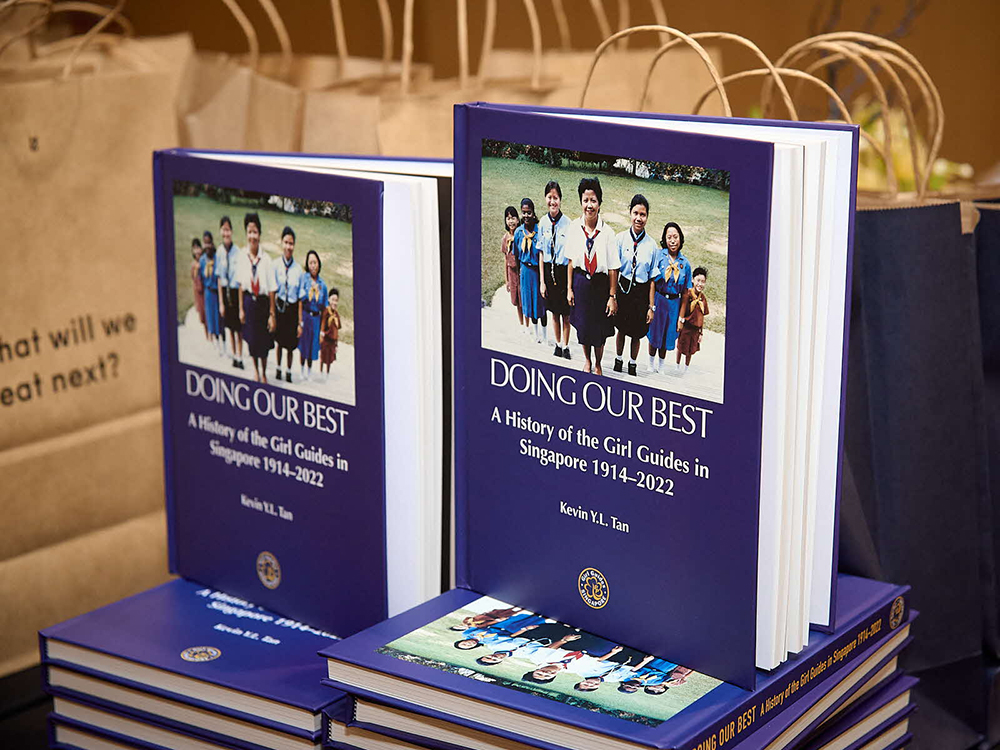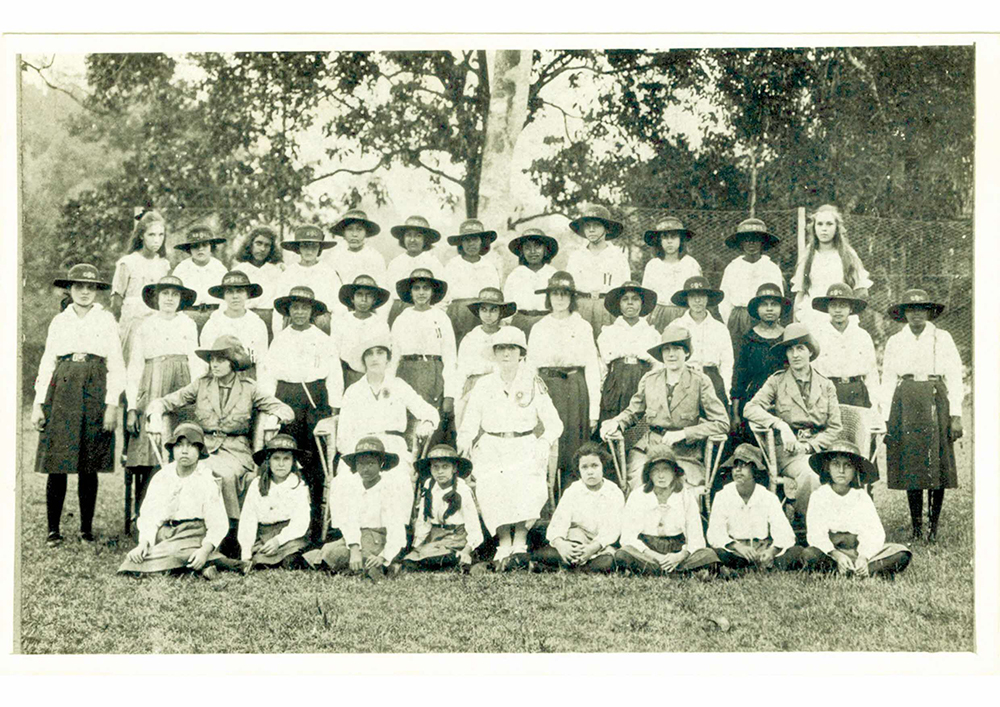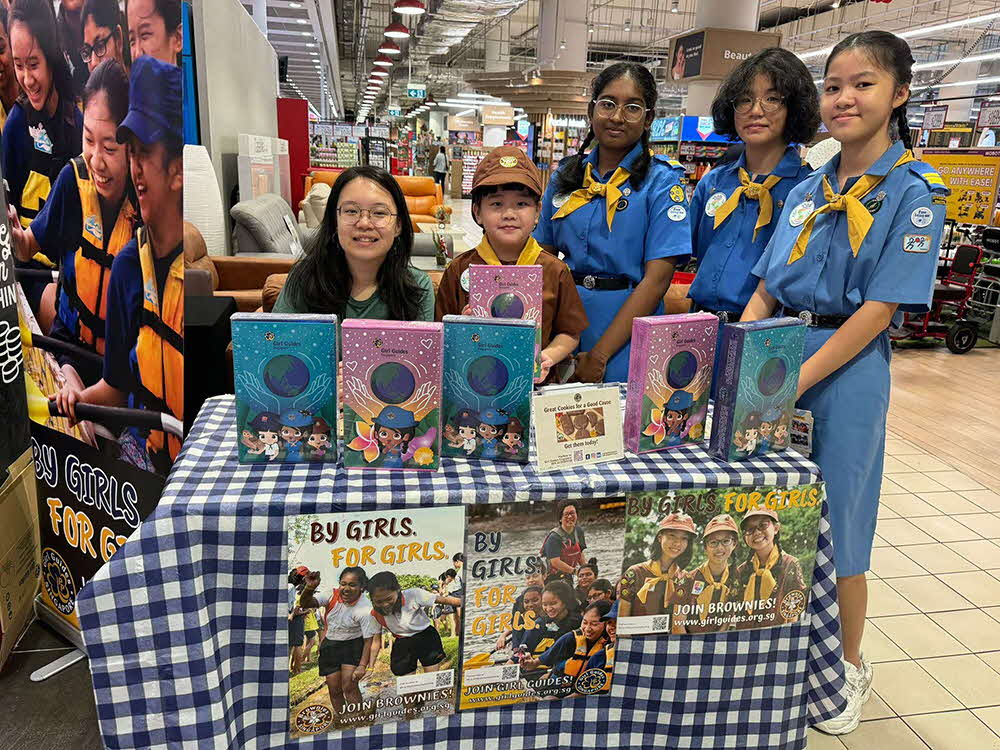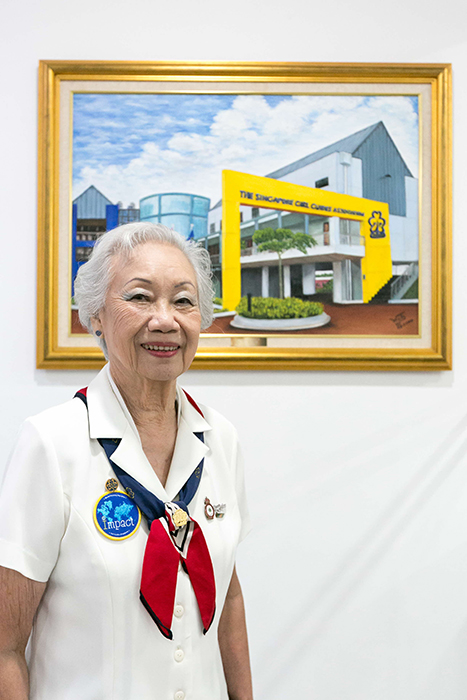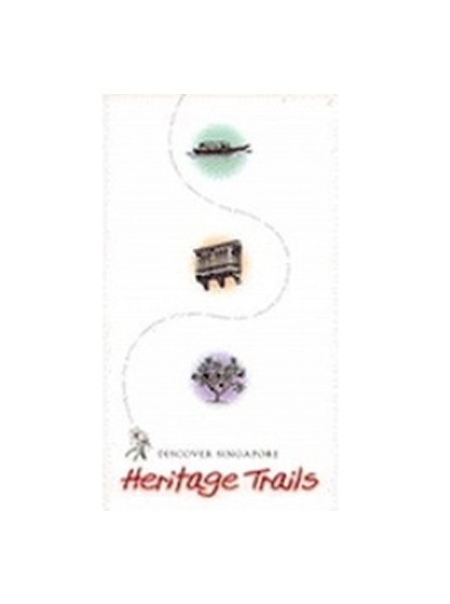TL;DR
The scouting revolution that captivated scores of young English boys in London in the 1900s inspired girls to gate-crash scouting activities, ultimately leading to the establishment of their own movement, the Girl Guides. The movement reached Singapore’s shores soon after in the mid-1910s. The publication of a book on the history of Girl Guiding in Singapore more than a century later in 2023, captures the key milestones and achievements of the largest volunteer organisation for girls and women in the city-state. MUSE SG speaks with three decorated Girl Guides behind the book project.
The three of you have 98 years of combined experience with the Girl Guides Singapore. How do you spot a Girl Guide in the wild?
Goh Soon Poh: Girls who know how to find their way around. Guides are very good with maps and navigating.
Mas’amah Ruah: I work in the school system so when I see teachers who are quick at tying knots or well-organised when it comes to planning activities and school events, I ask if they were guides or brownies. And most of the time I’m right. Girl Guides generally know how to start a fire, how to wield an axe, and how to camp in the wilderness. I love camping and have enjoyed adventures all over the world, from Olympia in Greece to Ayer Keroh in Malacca.
Goh Soon Poh (bottom right), a former deputy chief commissioner of the Girl Guides Singapore (GGS), former Girl Guide Captain Mas’amah Ruah (bottom left), and Ada Fong, a former GGS’ communications commissioner (top row, middle) spoke to MUSE SG about their book project. Together with President’s Guide Hidayah Amin (top right), the four formed an advisory committee for the publication, Doing Our Best: A History of the Girl Guides in Singapore 1914-2022 which was authored by historian and law professor Kevin Y.L. Tan (top left). (Photo courtesy of Goh Soon Poh and GGS)
Doing Our Best: A History of the Girl Guides in Singapore 1914-2022. (Photo courtesy of Goh Soon Poh and GGS)
The Girl Guides are synonymous globally with cookie sales. Your uniforms are also iconic. Can you provide us with an insider’s perspective on the less visible but important values of being a Girl Guide?
Soon Poh: Cookie sales, a key vehicle for us to fundraise as a volunteer organisation, help girls shape their confidence. They learn how to manage money as well as propose and execute promotional and marketing initiatives. During my time on the cookie committee, we partnered with NTUC FairPrice to set up sales kiosks, allowing our girls to engage with real customers. Our brownies and guides came up with their own clever ideas like offering product samples and free gifts such as bookmarks to improve sales.
Ada: Guiding isn’t just about wearing the uniform, going camping and participating in the National Day Parade. There are many different aspects of guiding that often aren’t as visible. For example, the movement allows girls to grow in an environment where girls help girls. Senior guides who are more experienced provide encouragement for girls to step out of their comfort zones and try new things—from crafts to challenging outdoor activities and taking on leadership roles. Girls experience personal growth and development over time. There are other benefits such as international travel where guides get to meet members of overseas guiding organisations and help different communities.
Mas: For me, community service is at the heart of guiding. My captain, Anna Tham, instilled this in me when I was in my teens—she brought my unit to help the poorest of the poor. I recall scrubbing the dirty kitchens of old attap houses in my uniform. Today, we continue our community service efforts with vigour, and have adopted the Sree Narayana Mission Home, and work with other beneficiaries such as the St. John’s Home for Elderly Persons.
What inspired your team to document the Girl Guide’s history in Singapore?
Soon Poh: When Girl Guides Singapore (GGS) celebrated our centenary in 2017, the idea of a history book was floated but we lacked the resources to do one. Our brother organisation, the Singapore Scout Association, had done their own history book in 2002 and we were keen on accomplishing the same.
Mas:(chuckling) Whatever the boys can do, we can do better.
Soon Poh: Yes, it was a challenge to ourselves. We were committed to capturing the legacy of the guiding movement in Singapore and honouring generations of passionate volunteer guiders who helped grow and shape the organisation. With many of them now in their 80s and 90s, there was an urgent need to capture their memories.
Among them is Mrs Tham, Mas’ captain. Mrs Tham started out as a guide at the Methodist Girls’ School. She became principal of the Methodist Girls’ School and held various office holder positions at GGS. She was an invaluable resource for the book project for she had kept newspaper clippings of GGS over the years. Her folders were all very well-organised and neatly annotated. As a volunteer movement, we need leaders who are passionate to drive it. It is quite an achievement that we have lasted so long. The book project is really about people like Mrs Tham who have made the movement happen.
Ada: The organisation has stood the test of time and continues to be relevant to girls today. The secret to this success is our continued focus on developing girls even as our programmes, activities and people change and evolve. We wanted this captured in writing for posterity.
What was the project’s journey like?
Soon Poh: We started our efforts in earnest in early 2021, during the COVID-19 pandemic. Our appointed author, Kevin Tan, loves history and conducted a lot of research. He was a good choice as he co-wrote the book Scouting in Singapore 1910-2000 and is very knowledgeable about both the scouting and guiding movements in Singapore. In writing the history of the Girl Guides, he pulled out stories of bravery and boldness which not many people know about.
One of these is the story of a group of Girl Guides who formed a company in Singapore’s Changi Prison where they were interned during World War II. They invited other imprisoned women to become guides. Using scrap materials, the women embroidered and stitched together patchwork quilts. It kept them occupied in what must have been the toughest of times. Media reports note that their captors had given the green light for the quilts to be sent to the military hospital at Changi barracks, so the women wove personalised secret messages to alert their community that they were alive.[1] As mentioned in our book, one of the quilts is on display in London’s Imperial War Museum.
We received blessings from our National Council for the project and secured partial funding from the National Heritage Board (NHB) through the Minor Project Grant scheme. The rest of the funds came from individual donors. It really helped that our donors knew that we were getting grant support from NHB. Our headquarters also supported the endeavour—GGS’ lead fundraising and communications officer, Jalilah Johar, pulled out records and annual reports which we relied on for the project. Author Hidayah Amin did some research and interviews. The book was finally published in October 2023, and then launched in March the following year.
Did the book project take you down memory lane? What were some of your key takeaways from the project?
Mas: Working on the book brought back a lot of memories for me and reminded me of certain traits and characteristics that have come to define us as guides and guiders.
A key memory that surfaced was from my time as a teenage Girl Guide under Captain Anna Tham. She once brought us to participate in a flying fox activity with a group of Boy Scouts but us girls, in our skirts, were too shy to participate as the boys were looking on from the sidelines. Guess what happened? Captain Anna, who was in uniform, gamely led by example. She climbed up and completed the activity while in her skirt. Emboldened by her courage, we followed suit.
I’m now a senior but I still train younger Girl Guides and much of what I do requires me to lead by example, just like Captain Anna. A guider is like a Swiss Army Knife, we’ve to pick up skills of all kinds like cooking with wood fire, working with axes and tying ropes. We’ve to model these techniques to the girls in our care.
Ada: I enjoyed seeing history come to life. The movement in Singapore began with expatriates directly and indirectly involved in the colonial service, then it transitioned to local hands in 1959 with Puan Noor Aishah, the first lady of Singapore, becoming the first Asian president of the Girl Guides Association. Just thinking about the growth the movement has experienced since then, and seeing the range of photos that emerged from the 1970s and the 1980s—with particular regard to the sheer number and diversity of girls involved—has been mind boggling and very striking.
Association patron and First Lady Puan Noor Aishah laying the foundation for a new Guide House on Clemenceau Avenue on February 26, 1966. Today, GGS’ headquarters is located in Bishan which opened its doors in 1999. (Photo courtesy of GGS)
The Guide Handbook which was published in 1976. (Photo courtesy of GGS)
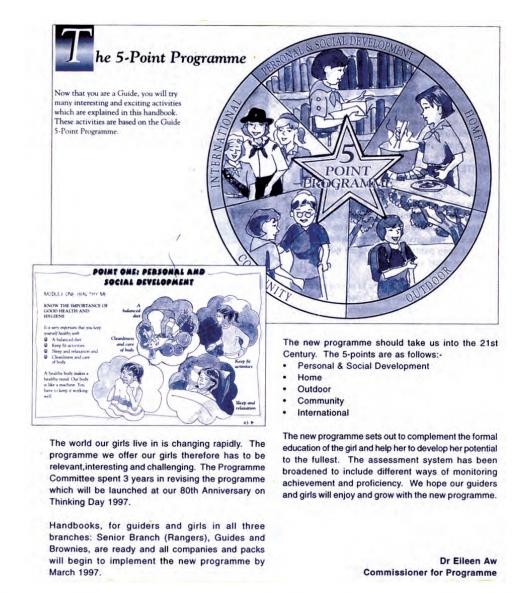
GGS’ 5-Point Programme which outlined key goals and behaviours for guides to thrive. The movement works to empower girls and young women to develop leadership skills, confidence and a sense of social responsibility. (Photo courtesy of GGS)
How did you launch the book?
Soon Poh: The book launch was held on March 30, 2024 at the Asian Civilisations Museum. There was a panel discussion which was designed to reflect the intergenerational nature of our organisation, followed by a reception. The panel included former President’s Guide Jayce Ho, one of Singapore’s first female pitmasters. She smokes meat as a day job, having been inspired by her early guiding experiences where she learned how to chop wood with an axe and manage fires.

From left to right: The book launch featured a panel discussion with President’s Guide Jayce Ho, author Kevin Tan, former GGS Chief Commissioner Dr Eileen Aw, as well as Brownie Shannon Teo and Guide Jayaraj Joshna. It was moderated by GGS’ Young Adult member, Chloe Chui. (Photo courtesy of GGS)
Later in the day, we held a campfire under the stars for our girls and their parents, at our campsite Camp Christine at Jalan Bahtera in Lim Chu Kang.
We decided not to sell the book. Instead, we’ve made it available to schools with Brownie and Girl Guide units. We have also given copies of the book to the National Library Board and its branches, as well as other partner uniformed groups and our regional and international counterparts. To increase our reach, we’ve made the publication available on our website.
What is the role of a Girl Guide today? How do personalities like war hero and guide Elizabeth Choy inspire your girls?
Soon Poh: It’s not about looking up towards a small group of strong female leaders. Yes, they do inspire us, but our movement builds leaders in each of us. You don't have to be a chief executive officer of a company or permanent secretary to be a leader. Our girls can be leaders wherever they are—in the classroom setting among their peers, or at home with their siblings. We don’t take on the world’s definition of a leader.
Ada: That’s the inclusive bit about guiding which is something I find so inspiring. You don’t need any qualifications to join the movement. Any girl can join the Girl Guides and pick up practical skills from scratch. We don’t have age limits either—some of our Trefoil Guild senior members in their 70s and 80s cook for seniors and families in the Bishan community once a month.
Mas: Lord Baden-Powell, who initiated both the scouting and guiding movements, was a very creative man. If you read his books, you will see that he designed scouting for both boys and girls. He shared the importance of being respectful to nature across all the games he devised. He came from a different era, but his ideals are still relevant today. If you love scouting and guiding, you’ll have all the basics to tackle all that’s happening in the world today like climate change. If you respect nature, save water and electricity, you’ve already incorporated some key guiding principles in your life.
This project was supported by the National Heritage Board’s Minor Project Grant.






